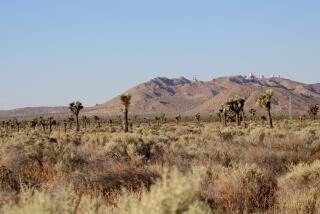Fossilized Ideas on Energy
- Share via
It’s a bit hard to fathom why the Los Angeles Department of Water and Power has been planning to invest as much as $400 million in the expansion of a giant air-polluting, coal-fired power plant in Utah just as pollution-free renewable sources of electricity are coming into common use and becoming more affordable. Fortunately, Mayor James K. Hahn last week ordered the DWP to pull the plug on this dinosaur of a power plant, telling the department to spend the money on renewables instead. It was a bold and welcome act needed to wrench the DWP out of its outdated thinking.
Because of California’s clean-air laws, the plant probably couldn’t be built here. Utah is apparently less concerned with smog, despite warnings from the National Park Service that emissions from the Intermountain Power Agency’s proposed facility in the west-central Utah town of Delta would threaten visibility in Zion, Bryce Canyon, Capitol Reef, Canyonlands and Arches national parks. Trashing Utah and its natural treasures isn’t the best way to fill L.A.’s energy needs.
Under pressure from environmentalists, Los Angeles recently committed to boost its use of renewable energy sources from 3% to 20% by 2017. That followed an order from the state Legislature last year for private utilities to meet the same goal. But in another sign of the DWP’s muddled thinking, the agency claimed that hydroelectric power from Hoover Dam could be counted as renewable. The Legislature specifically excluded power from large hydroelectric plants in its mandate for private utilities. Hahn and the City Council should reject this idea.
Even with Hahn’s order, Los Angeles still will get about half its electric power from coal-fueled plants in Arizona, Nevada and Utah. One major source is the Southern California Edison-operated Mohave Generating Station in Laughlin, Nev.
The future of the Mohave plant is now before the California Public Utilities Commission, which is considering whether to order up to $1 billion in new pollution controls or to simply shut it down. The Natural Resources Defense Council has proposed an alternative -- that Edison continue operating it temporarily while developing more renewable sources of power and smaller, cleaner plants. Mohave’s coal comes from Navajo and Hopi reservations. The environmentalists said a shutdown would devastate the tribes economically, and installation of new pollution controls would require a shutdown for several years. The PUC should take a close look at the environmentalists’ plan.
California should seek any reasonable methods that reduce reliance on coal, truly a fossil of a fuel.
More to Read
Sign up for Essential California
The most important California stories and recommendations in your inbox every morning.
You may occasionally receive promotional content from the Los Angeles Times.










